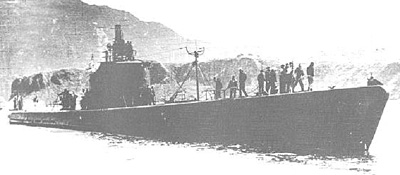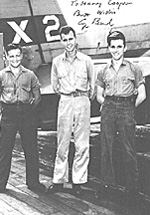 Built by: Portsmouth Naval Shipyard
Built by: Portsmouth Naval Shipyard
Design: Government
Keel laid: 5 July 1939
Launched: 25 March 1940
Sponsor: Mrs. Ernest J. King (the wife of CNO Admiral King)
Commissioned: 15 August 1940
First Skipper: LCDR Willis A. Lent
Here’s an abridged history of USS TRITON, sent to us by JAMES SANTOS (4896-A/LIFE1996):
December 7, 1941 –Pearl Harbor Submarine Base was home for the 22 submarines all under the command of Rear Admiral Thomas Withers. On that fateful Sunday in December, the submarines of the Pacific Fleet were widely dispersed. Six (the older S-Boats) were dispersed along the west coast of the United States, undergoing repairs or being used in training exercises at San Diego.
At the time the Japanese struck, ARGONAUT and TROUT were conducting defensive patrols near Midway Island. TAMBOR and TRITON were patrolling off Wake Island. About 0700 on 8 December (Wake Island time) the garrison there received word of the Pearl Harbor attack. Mid-morning of the same day, enemy bombers from Kwajalein began their bombardment. TAMBOR and TRITON were on practice war patrols off Wake when the Japanese struck. It was at this time that they began to take an active part in the defense of Wake Island.
Two days of aerial bombing preceded the arrival of a Japanese task force consisting of three light cruisers, six destroyers, two transports and two scouting submarines. Patrolling south of Wake, TRITON found herself in position to intercept the enemy naval force. Just before midnight on December 10 and while on the surface, the OOD sighted an enemy Man-O-War silhouetted against the sky, lit by the attack on Wake Island. Her Skipper, LCDR W. A. Lent, having orders not to attack unless attacked, gave the command to go deep and rig for depth charge. After three hours of playing cat and mouse with the enemy ship, Lent decided to attack.
At 0317 he maneuvered TRITON into position and fired four torpedoes from the stern tubes. Fifty-eight seconds after the first fish left the tube, an explosion was heard. USS TRITON had just completed the first torpedo attack made by a Pacific Fleet submarine in World War II.
April and May of 1942 found TRITON patrolling in the vicinity of the Marshall Islands. With her new Skipper, LCDR C. C. Kirkpatrick, she was putting on quite a show for the Japanese. Kirkpatrick had been hand-picked for the job of Skipper of USS TRITON because of his aggressive nature and his experience as the Skipper of a destroyer. Under his command, TRITON amassed quite a record in April and May of 1942. During the last seven days of April and the first 21 days of May, she sank seven Japanese ships totaling 21,404 tons. The ships she sank were a trawler, a freighter, two passenger/cargomen and a submarine. She also sank two sampans in surface gun attacks.
This action, combined with those of her sister-ship USS TAUTOG, marked the beginning of a new and aggressive mindset of the submarine sailor. Both Captain and crew were dedicated to sending as many Japanese ships to the bottom as possible, and they were doing it in a manner that showed complete disregard for their own safety. It was during this early of the war that the tradition and history of the U.S. Naval Submarine Service was born. It is a tradition that carries on today into the modern navy.
In July 1942, the loss of S-27 had created a gap in the defense of the Aleutian Islands so in June 1942, TRITON and seven other modern American submarines were assigned to patrol the waters of the North Pacific. In addition, four S-Boats were also assigned.
The boats began to score against enemy shipping almost as soon as they arrived. The first to sink an enemy ship was TRITON. On her fourth war patrol, she was manned by a very experienced crew and the same Captain Kirkpatrick who had conducted such a successful campaign earlier. TRITON was under orders to patrol off the south coast of Aggatu and was on station beginning 3 July.
On the morning of 4 June, a brief thinning of the fog revealed a Japanese destroyer. TRITON and her crew began the hunt. She pursued her quarry for ten hours before firing two torpedoes. One struck the destroyer amidships, leaving her with a portside list. As the crew of TRITON watched through the periscope, the stricken enemy ship began to roll and eventually capsized. The crew watched as approximately 100 Japanese officers and crew, dressed in whites, walked down the starboard side of the ship and jumped into the icy waters. The day was 4 July 1942 (American Independence Day) and the crew of TRITON celebrated accordingly. The destroyer was the 1,600 ton NENOHI.
TRITON patrolled these same waters for the rest of the month and on 28 July, she was patrolling the approaches to Kiska Harbor with GRUNION. They were ordered to return to Dutch Harbor on the 30th. TRITON returned – but GRUNION was never heard from again, and her disappearance remains a mystery to this day.
Cutting the Japanese supply lines was an important function of the submarines that patrolled the North Pacific, but it was rough duty, especially for the S-Boats. LCDR Vincent A. Sisler, the Skipper of S-28, describes the conditions:
“It was necessary to lash lookouts, the officer of the deck and the quartermaster to the bridge to keep them from being bashed about by the waves that rolled over the boat. Amazing that all hands didn’t have severe colds and pneumonia, but health in general was excellent. The big problem turned out to be teeth. They decayed quickly for lack of calcium. Calcium pills soon became standard issue as did sun lamps.”
With the onset of winter, the submariner dressed for bridge duty in heavy woolen underwear, a woolen hunting shirt, two pairs of woolen submarine trousers, three pairs of heavy wool socks, aviator fleece-lined boots plus flexible rubber boots. Then he would don a pair of trousers lined with sponge rubber and put on more sweaters and a parka. Regulation rain gear would be put on if the weather was REALLY bad. Two pairs of wool mittens covered by rubber surgical gloves would finish the ensemble.
EDITOR NOTE – We bet this image never made it to the recruiting posters!
From personal experience, having made a transit patrol as a lookout on USS BANG, I can tell you that this is the way to dress when taking green water over the bridge!
December of 1942, the end of the first year at war, found TRITON along with FINBACK and PIKE, performing a new type of mission. Strung out in a line across the ocean, they larked the way for the LIBERATOR strike at Wake. Their mission was to provide aerial navigators information that would allow them to home in on their target. In addition, they were to home in on their target. In addition, they were to perform rescue duty for any downed pilots. This was the first of many such assignments for the US Submarine Service during World War II.
EDITOR NOTE – It was USS FINBACK that saved the life of GEORGE BUSH (4116-1995) when he went down in the Pacific off Chichi-Jima and prevented him from becoming the main course at the Japanese mess hall. That garrison commander was convicted of having American aviators cooked and eaten by his men.
 GEORGE HERBERT WALKER BUSH and his aircrew
GEORGE HERBERT WALKER BUSH and his aircrew
TRITON departed Brisbane, Australia for the last time on 16 February 1943. Under command of LCDR G. K. McKenzie, she was to hunt enemy traffic between Rabaul and the Shortland Basin. The loss of AMBERJACK, GRAMPUS and ARGONAUT already that year was a growing testimony to the proficiency of Japanese ASW units.
On 6 March 1943, TRITON reported a battle with a Japanese convoy of five ships escorted by a destroyer. In this battle, she sank KIRIAH MARU, a 3,057 ton freighter, and damaged another cargo vessel. Forced deep by a malfunctioning torpedo that circled, she had to break off the attack.
On 8 March, she attacked another escorted convoy but was forced deep by a destroyer before she could see the results of the eight torpedoes that she fired. On 11 March, Brisbane received the last message from TRITON. She reported: “Two groups of smokes, five or more ships each plus escorts. Am chasing.”
Two days later, a message was sent to TRITON informing her that three Japanese destroyers were operating in her area on ASW duty. She did not acknowledge that message.
On 25 March, she was sent another message to clear her area, but she did not respond. She was reported overdue and presumed lost when she did not arrive at Brisbane on the scheduled date. Information obtained after the war left little doubt as to the time and place of TRITON’s last battle. She went down fighting just north of the Admiralty Islands on 15 March in combat with the three destroyers that Brisbane was trying to warn her about. Veteran of the war’s beginning, the first submarine in combat to fire a torpedo at the enemy, TRITON had sunk eleven Japanese vessels totaling 31,788 tons.
The Japanese battle reports describe a barrage of depth charges that resulted in “a great quantity of oil, pieces or wood and cork, and manufactured goods bearing the legend MADE IN THE USA.” But as to who really sank TRITON??????
From the time I first remember till the day he died, my father would not purchase goods made in Japan. A difficult thing to do today, but something worth thinking about if you rode the boats during World War II.
Thanks for this report JIM. Here is the official record from the US Navy regarding USS TRITON, dated 15 March 1943.
“Last heard from on 11 March 1943. Japanese information indicates that TRITON was almost certainly sunk by depth charge attack of Japanese destroyers on 15 March 1943. It was reported that “a great quantity of oil, pieces of wood and cork, and manufactured goods bearing the label ‘Made in U.S.A.’ was sighted after the attack.”
USS TRITON and her crew of 79 never returned to Brisbane and are still on “Eternal Patrol”.
Commanding Officers of USS TRITON were:
W. A. Lent – patrols 1 and 2;
C. C. Kirkpatrick – patrols 3, 4 and 5;
G. K. McKenzie – patrol 6.
| Sinkings by USS TRITON | |||
|---|---|---|---|
| Under W. A. Lent | |||
| 02.17.42 | SHINYO MARU #5 | freighter | 1,498 GRT |
| 02.21.42 | SHOKYU MARU | freighter | 4,484 GRT |
| Under C. C. Kirkpatrick | |||
| 23.04.42 | unknown | trawler | 1,000 GRT |
| 01.05.42 | CALCUTTA MARU | passenger | 5,339 GRT |
| 06.05.42 | TAICI MARU | freighter | 2,209 GRT |
| 06.05.42 | TAIGEN MARU | passenger | 5,660 GRT |
| 17.05.42 | I-164 | submarine | 1,635 GRT |
| 04.06.42 | NENOHI | destroyer | 1,600 GRT |
| 24.12.42 | AMAKASU MARU #1 | water tanker | 1,913 GRT |
| 28.12.42 | OMI MARU | passenger | 3,393 GRT |
| Under G. K. McKenzie | |||
| 06.03.43 | KIRIHA MARU | freighter | 3,057 GRT |
USS TRITON received five Battle Stars during her time in WW II.
Back to KTB # 178 Table of Contents
Back to KTB List of Issues
Back to MagWeb Master Magazine List
© Copyright 2004 by Harry Cooper, Sharkhunters International, Inc.
This article appears in MagWeb.com (Magazine Web) on the Internet World Wide Web. Other articles from military history and related magazines are available at http://www.magweb.com
Join Sharkhunters International, Inc.: PO Box 1539, Hernando, FL 34442, ph: 352-637-2917, fax: 352-637-6289, www.sharkhunters.com
